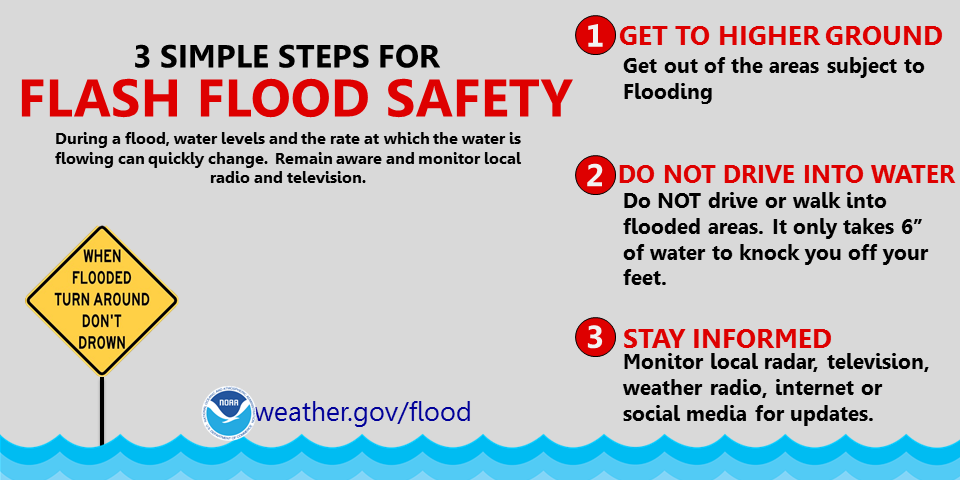Flash Flood Emergency: Prevention, Response, And Recovery

Table of Contents
Flash Flood Prevention: Minimizing Your Risk
Proactive measures are key to mitigating the impact of a flash flood. By understanding your risk and implementing preventative strategies, you can significantly reduce the potential for damage and injury.
Understanding Flash Flood Risk Factors
Identifying areas prone to flash flooding is the first step in effective prevention.
-
Identify high-risk areas: Live near rivers, streams, creeks, canyons, mountains, or in low-lying areas? You're at higher risk. Flash floods often occur in normally dry washes or arroyos.
-
Recognize dangerous weather: Heavy rainfall, especially in short periods, and thunderstorms are major flash flood triggers. Pay close attention to weather forecasts and warnings.
-
Check flood risk maps: Utilize resources like the National Weather Service (or your country's equivalent) to access flood risk maps for your area. These maps identify areas with a higher probability of flooding.
-
Other factors to consider:
- Local watershed: Understand how your local watershed behaves during heavy rain.
- Soil saturation: Saturated soil cannot absorb additional water, increasing runoff and flash flood risk.
- Upstream construction: Construction projects upstream can alter drainage patterns and increase flood risk downstream.
Implementing Protective Measures
Taking proactive steps to protect your property can lessen the damage caused by a flash flood.
-
Improve drainage: Maintain clean gutters and downspouts to efficiently direct water away from your foundation. Consider installing a French drain or other drainage solutions for improved water management.
-
Elevate valuables: Move important documents, appliances, and furniture to upper floors or elevated storage.
-
Construct barriers: Sandbags or other barriers can help divert floodwaters away from your home's foundation.
-
Essential preventative steps:
- Flood insurance: Consider purchasing flood insurance, even if you're not in a high-risk zone. Standard homeowner's insurance often doesn't cover flood damage.
- Emergency plan: Develop a comprehensive family emergency plan that includes evacuation routes and meeting points.
- Emergency kit: Assemble a flash flood emergency kit containing essential supplies like water, food, first-aid supplies, and important documents.
Community-Based Prevention
Community involvement plays a vital role in flash flood prevention and preparedness.
-
Support flood mitigation: Participate in or support local initiatives aimed at flood mitigation, such as wetland restoration projects.
-
Advocate for infrastructure: Advocate for improvements to local drainage systems and infrastructure to better manage water runoff.
-
Community preparedness: Participate in community preparedness programs and workshops offered by local emergency management agencies.
-
Collective action:
- Inform neighbors: Share information about flood risks and preparedness strategies with your neighbors.
- Volunteer for cleanup: Volunteer to assist with flood cleanup efforts after a flood event.
- Educate children: Teach children about flash flood safety and what to do in case of a flood.
Flash Flood Response: Staying Safe During a Flood
Knowing how to respond quickly and effectively during a flash flood is crucial for protecting yourself and your loved ones.
Immediate Actions
When a flash flood warning is issued, act swiftly.
-
Evacuate immediately: Move to higher ground immediately if instructed by authorities. Don't wait for the floodwaters to arrive.
-
Avoid floodwaters: Never drive or walk through floodwaters. The depth and current may be deceivingly strong, and the water may be contaminated.
-
Turn off utilities: Turn off gas, electricity, and water to prevent further damage and hazards.
-
Critical steps during a flash flood:
- Contact emergency services: Call emergency services to report your situation and request assistance if needed.
- Seek shelter: If evacuation is impossible, seek shelter in a sturdy building on higher ground.
- Stay informed: Stay updated on the situation through official channels like weather alerts and emergency broadcasts.
Protecting Your Property
While personal safety is paramount, taking steps to protect your property can also minimize losses.
-
Move valuables: Relocate valuable items to upper floors or a safe, dry location.
-
Protect your home: Use sandbags or other barriers to protect your home's foundation from rising floodwaters.
-
Secure loose objects: Secure any loose outdoor objects that could be swept away by floodwaters, causing damage or injury.
-
Important documentation:
- Photo/video documentation: Take photos and videos of any damage to your property for insurance claims.
- Record losses: Document any injuries or losses incurred due to the flash flood.
Post-Flood Safety
The dangers don't end when the floodwaters recede. Remain vigilant about post-flood safety hazards.
-
Avoid floodwaters: Floodwaters can be contaminated with sewage, chemicals, and debris. Avoid contact.
-
Beware of hazards: Be cautious of downed power lines, damaged structures, and other potential hazards.
-
Check for gas leaks: Check for gas leaks before entering your home after a flood.
-
Post-flood precautions:
- Follow instructions: Follow instructions from emergency personnel and local authorities.
- Avoid contaminated debris: Avoid touching or handling contaminated debris without proper protective gear.
- Caution entering damaged structures: Exercise extreme caution when entering flood-damaged structures due to potential structural instability.
Flash Flood Recovery: Rebuilding and Recovering
Recovering from a flash flood requires careful planning, patience, and potentially significant effort.
Assessing the Damage
Thoroughly assess the extent of the damage to your property and belongings.
-
Document damage: Take detailed photos and videos of all damage to your property and possessions.
-
Contact insurance: Contact your insurance company immediately to report the damage and begin the claims process.
-
Seek assistance: Contact local authorities and relief organizations for assistance and resources.
-
Essential post-flood steps:
- Inventory losses: Create a detailed inventory of lost or damaged items for insurance purposes.
- Obtain repair estimates: Obtain estimates from contractors for necessary repairs and reconstruction.
- Understand insurance coverage: Understand your insurance coverage and what expenses it will cover.
Cleaning Up Safely
Cleaning up after a flash flood requires careful attention to safety and health hazards.
-
Use safety gear: Wear appropriate safety gear, including gloves, masks, and protective clothing.
-
Dispose of waste: Dispose of contaminated materials properly according to local guidelines.
-
Health hazards: Be aware of potential health hazards like mold, bacteria, and other contaminants.
-
Cleanup considerations:
- Professional help: Consider hiring professional cleanup services for extensive damage.
- Disinfection: Thoroughly disinfect all contaminated areas to prevent mold and bacterial growth.
- Material replacement: Replace any damaged materials that cannot be effectively cleaned or repaired.
Rebuilding and Repairing
Rebuilding and repairing your property after a flash flood can be a complex process.
-
Permits and codes: Obtain necessary permits and follow all building codes during reconstruction.
-
Flood mitigation: Incorporate flood mitigation measures into your reconstruction plans to prevent future damage.
-
Professional assistance: Hire qualified professionals for major repairs and reconstruction projects.
-
Long-term recovery:
- Government assistance: Explore available government assistance programs and financial aid options.
- Financial management: Carefully manage your finances during the recovery process.
- Prioritize repairs: Prioritize repairs based on urgency and safety concerns.
Conclusion
Flash flood emergencies demand preparation, swift response, and diligent recovery. By understanding the risks, implementing preventative measures, and knowing how to react during and after a flood, you significantly increase your chances of staying safe and minimizing the impact on your life and property. Remember to always stay informed about weather conditions, heed official warnings, and have a comprehensive flash flood emergency plan in place. Don’t wait until it’s too late – prepare for a flash flood emergency today and protect yourself and your loved ones. Take control of your flash flood preparedness and build a safer future.

Featured Posts
-
 2025 Memorial Day Travel Finding The Least Crowded Flights
May 25, 2025
2025 Memorial Day Travel Finding The Least Crowded Flights
May 25, 2025 -
 Flying During Memorial Day 2025 Peak Travel Dates And Tips
May 25, 2025
Flying During Memorial Day 2025 Peak Travel Dates And Tips
May 25, 2025 -
 The Sound Of Disaster Analyzing The Titan Sub Implosion Footage
May 25, 2025
The Sound Of Disaster Analyzing The Titan Sub Implosion Footage
May 25, 2025 -
 Annie Kilners Posts Following Kyle Walker Night Out Allegations Of Poisoning
May 25, 2025
Annie Kilners Posts Following Kyle Walker Night Out Allegations Of Poisoning
May 25, 2025 -
 Demna Gvasalia Shaping The Future Of Gucci
May 25, 2025
Demna Gvasalia Shaping The Future Of Gucci
May 25, 2025
Latest Posts
-
 De Minaur Out Of Madrid Open After Straight Sets Loss Swiatek Triumphs Over Keys
May 25, 2025
De Minaur Out Of Madrid Open After Straight Sets Loss Swiatek Triumphs Over Keys
May 25, 2025 -
 Alex De Minaurs Madrid Open Exit Straight Sets Defeat And Swiateks Victory
May 25, 2025
Alex De Minaurs Madrid Open Exit Straight Sets Defeat And Swiateks Victory
May 25, 2025 -
 Ealas Historic Grand Slam Appearance In Paris
May 25, 2025
Ealas Historic Grand Slam Appearance In Paris
May 25, 2025 -
 Alex Ealas Paris Grand Slam Expectations And Preparations
May 25, 2025
Alex Ealas Paris Grand Slam Expectations And Preparations
May 25, 2025 -
 Grand Slam Debut Alex Eala Set For Paris
May 25, 2025
Grand Slam Debut Alex Eala Set For Paris
May 25, 2025
